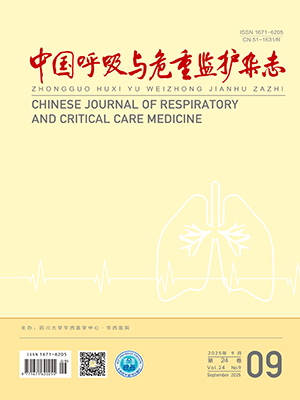| 1. |
Flanders SA, Stein J, Shochat G, et al. Performance of a bedside C-reactive protein test in the diagnosis of community-acquired pneumonia in adults with acute cough. Am J Med, 2004, 116: 529- 535.
|
| 2. |
Almirall J, Bol í bar I, Toran P, et al. Contribution of C-reactive protein to the diagnosis and assessment of severity of communityacquired pneumonia. Chest, 2004, 125: 1192-1195.
|
| 3. |
Smith RP, Lipworth BJ. C-reactive protein in simple communityacquired pneumonia. Chest, 1995, 107: 1028-1031.
|
| 4. |
Offidani M, Corvatta L, Malerba L, et al. Diagnostic value of Creactive protein in discriminating fungal from nonfungal pulmonary infiltrates in patients with hematologic malignancies. Support Care Cancer, 2006, 14: 874-877.
|
| 5. |
P ó voa P, Coelho L, Almeida E, et al. C-reactive protein as a marker of infection in critically ill patients. Clin Microbiol Infect,2005, 11: 101-108.
|
| 6. |
Chan YL, Tseng CP, Tsay PK, et al. Procalcitonin as a marker of bacterial infection in the emergency department: an observational study. Crit Care, 2004, 8: R12-R20.
|
| 7. |
Pelosi P, Barassi A, Severgnini P, et al. Prognostic role of clinical and laboratory criteria to identify early ventilator-associated pneumonia in brain injury. Chest, 2008, 134: 101-108.
|
| 8. |
Gendrel D, Raymon J, Moulin F, et al. Procalcitonin in community-acquired pneumonia: comparison with interleukin-6, Creactive protein, and interferon-alpha for diagnosis of bacterial vs.viral infections in children. Abstr Intersci Conf Antimicrob Agents Chemother Intersci Conf Antimicrob Agents Chemother, 1999 , 39 :237.
|
| 9. |
Masi á M, Guti é rrez F, Shum C, et al. Usefulness of procalcitonin levels in community-acquired pneumonia according to the patients outcome research teampneumonia severity index. Chest, 2005, 128 :2223-2229.
|
| 10. |
Shehabi Y, Seppelt I. Pro /Con debate: Is procalcitonin useful for guiding antibiotic decision making in critically ill patients? Critical Care, 2008, 12: 211.
|
| 11. |
Schuetz P, Christ-Crain M, M ü ller B. Procalcitonin and other biomarker to improve assessment and antibiotic stewardship infections-hope for hype? Swiss Med Wkly, 2009, 139: 318-326.
|
| 12. |
Hedlund J, Hansson LO. Procalcitonin and C-reactive protein levels in community-acquired pneumonia: correlation with etiology and prognosis. Infection, 2000, 28 : 68 -73.
|
| 13. |
Holm A, Pedersen S, Nexoe J, et al. Procalcitonin versus Creactive protein for predicting pneumonia in adults with lower respiratory tract infection in primary care. Br J Gen Pract, 2007,57: 555-560.
|
| 14. |
Schleicher GK, Herbert V, Brink A, et al. Procalcitonin and Creactive protein levels in HIV-positive subjects with tuberculosis and pneumonia. Eur Respir J, 2005, 25: 688-692.
|
| 15. |
Tejera A, Santolaria F, Diez ML, et al . Prognosis of community acquired pneumonia ( CAP) : value of triggering receptor expressed on myeloid cells-1 ( TREM-1 ) and other mediators of the inflammatory response. Cytokine, 2007, 38: 117-123.
|
| 16. |
Chao WC, Wang CH, Chan MC, et al. Predictive value of serial measurements of sTREM-1 in the treatment response of patients with community-acquired pneumonia. J Formos Med Assoc, 2007 , 106 : 187-195.
|
| 17. |
Huh JW, LimCM, Koh Y, et al. Diagnostic utility of the soluble triggering receptor expressed on myeloid cells-1 in bronchoalveolar lavage fluid from patients with bilateral lung infiltrates. Critical Care, 2008, 12: R6.
|
| 18. |
Determann RM, Millo JL, Gibot S, et al. Serial changes in soluble triggering receptor expressed on myeloid cells in the lung during development of ventilator-associated pneumonia. Intensive Care Med, 2005, 31: 1495-1500.
|
| 19. |
Christ-Crain M, Schuetz P, M ü ller B, et al. Biomarkers in the management of pneumonia. Expert Rev Respir Med, 2008, 2: 565-572.
|




